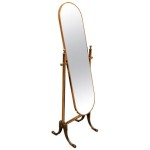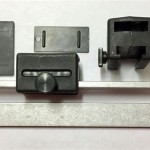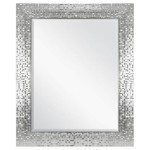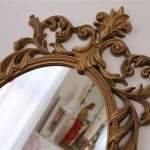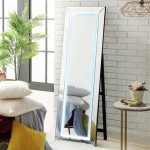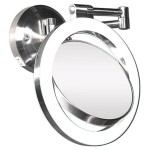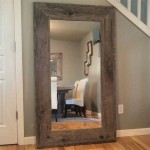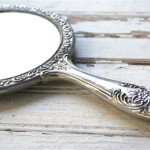Angled Wall Mirrors: A Comprehensive Guide
Angled wall mirrors offer a unique blend of functionality and aesthetic appeal. Their tilted reflective surface provides unconventional viewing angles, making them suitable for various applications, from grooming and makeup application to architectural enhancements and spatial illusions.
Key Features of Angled Wall Mirrors
Several key aspects distinguish angled wall mirrors from their traditional counterparts. Understanding these characteristics allows for informed selection and optimal utilization:
- Tilted Reflective Surface: The defining feature, allowing for adjusted viewing angles not achievable with standard flat mirrors.
- Versatile Mounting Options: Depending on the design, they can be wall-mounted, freestanding, or integrated into furniture.
- Variety of Shapes and Sizes: Available in numerous shapes, from classic rectangles and squares to more elaborate designs, catering to diverse aesthetic preferences.
Applications of Angled Wall Mirrors
The unique properties of angled mirrors lend themselves to a range of practical and decorative uses:
- Makeup Application and Grooming: The adjustable angle allows for a precise view, simplifying tasks requiring close-up detail.
- Hair Styling: Provides views of the back of the head, facilitating self-styling and ensuring comprehensive coverage.
- Accessibility Solutions: Can assist individuals with mobility limitations by offering alternative viewing angles.
- Retail Displays: Enhance product visibility by allowing customers to view items from multiple perspectives.
Benefits of Using Angled Wall Mirrors
Incorporating angled wall mirrors can yield several advantages:
- Improved Functionality: Offer tailored viewing experiences for specific tasks, enhancing practicality and ease of use.
- Enhanced Aesthetics: Introduce a dynamic element to interior design, adding visual interest and breaking the monotony of flat surfaces.
- Space Enhancement: Strategically placed angled mirrors can create an illusion of depth and spaciousness, particularly in smaller rooms.
Types of Angled Wall Mirrors
Angled wall mirrors come in various types to suit diverse needs and preferences:
- Adjustable Angled Mirrors: Allow users to modify the angle of the mirror as needed, providing maximum flexibility.
- Fixed Angled Mirrors: Offer a pre-set angle, ideal for specific purposes where consistent viewing is crucial.
- Three-Way Mirrors: Employ multiple angled mirrors to provide a comprehensive view from various angles simultaneously.
- Full-Length Angled Mirrors: Combine the benefits of angled viewing with a full-length perspective, ideal for outfit assessments.
Materials and Construction
Understanding the materials and construction of angled wall mirrors is essential for durability and longevity:
- Mirror Glass: The quality of the glass impacts the clarity and reflectivity of the mirror. High-quality glass offers a distortion-free image.
- Frame Material: Frames can be made from various materials, including wood, metal, and plastic, each offering distinct aesthetic and durability characteristics.
- Mounting Mechanism: Secure and robust mounting hardware is crucial for stability and safety.
Choosing the Right Angled Wall Mirror
Selecting the appropriate angled wall mirror requires careful consideration of several factors:
- Intended Use: The primary application will dictate the required size, angle, and type of mirror.
- Available Space: Measure the designated area carefully to ensure the mirror fits comfortably and proportionally.
- Aesthetic Considerations: The mirror's style and finish should complement the existing décor and personal preferences.
- Budget: Angled mirrors are available at various price points, allowing for selection within budgetary constraints.
Installation and Maintenance
Proper installation and maintenance contribute to the longevity and optimal performance of angled wall mirrors:
- Secure Mounting: Follow manufacturer instructions carefully to ensure secure and stable installation, using appropriate wall anchors if necessary.
- Cleaning: Regular cleaning with a suitable glass cleaner maintains clarity and prevents buildup of dust and grime.
- Inspection: Periodically inspect the mirror and mounting hardware for any signs of damage or looseness.
Integrating Angled Wall Mirrors into Interior Design
Angled mirrors can be seamlessly integrated into various interior design styles:
- Contemporary: Sleek, minimalist designs with metal frames complement contemporary aesthetics.
- Traditional: Ornate frames and beveled edges can enhance traditional interiors.
- Eclectic: Unique shapes and finishes can add a touch of individuality to eclectic spaces.
- Minimalist: Frameless or thinly framed angled mirrors maintain a sense of openness in minimalist settings.

How To Put A Mirror On An Angled Wall Over Bathroom Sink Vanity

New Large Angled Wall Mirror Foster In Gold Leaf For At 1stdibs On Slanted

Brass Angled Wall Mirror Fourth Interiors

Cleanpro Wall Mounted Cleanroom Mirror With Adjustable Tilt 18 X 30

Another Awesome Mulit Angled Mirror Wall Bedroom Lighted Bathroom

Jordan Wall Mirror Rectangular Shape With Angled Decorative Edg Ba Furniture Clearance

New Large Angled Wall Mirror Foster In Gold Leaf For At 1stdibs On Slanted

Geometric Angled Multi Diamond Large Abstract Wall Mirror Home Living

Yearn Mirrors Angled Wall Mirror Champagne 65x80cm Style

Neutype Arched Wall Mirror Small Arch Right Angle 38 X26 Gold Iron Com

